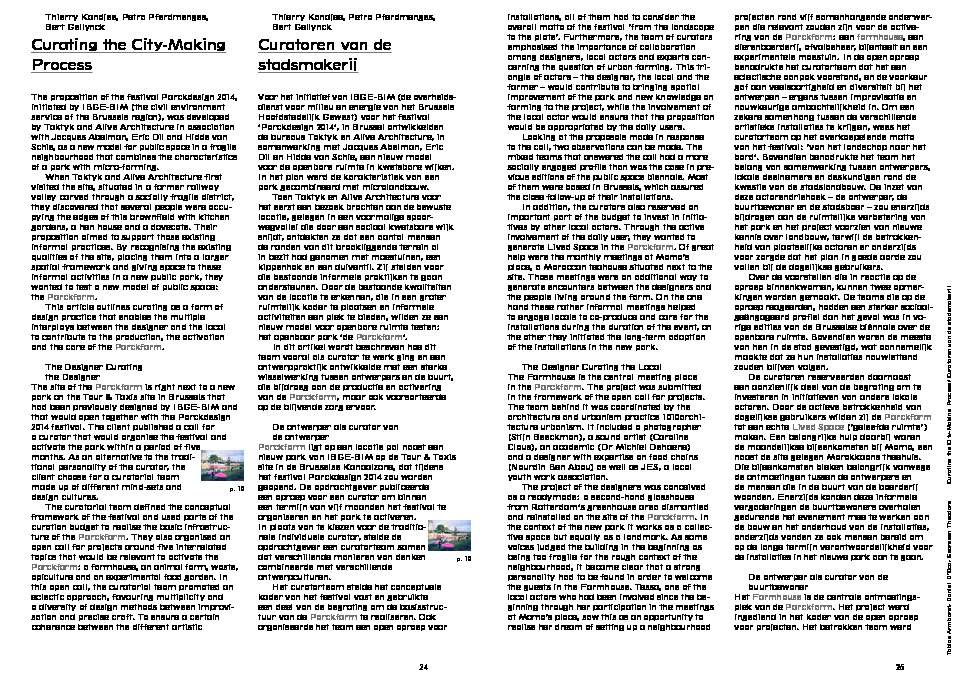Parckfarm
The Parckfarm project emerged in the summer of 2014 from the Parckdesign festival, a design biennial exploring possible avenues for creating alternative forms of public space in Brussels, an initiative of Brussels Environment. The 2014 edition promoted the participatory management of public green space, with a special focus on creativity and artistic practices. In other words, the focus shifted from 'built spaces' to 'lived spaces'. For the 2014 edition, the initiators of the festival decided to work with the abandoned residual space of Tour & Taxis, a neglected railway valley located between several multicultural neighbourhoods. Tour & Taxis is located in the border area between the municipalities of Molenbeek, Jette and Laeken, neighbourhoods burdened with high rates of unemployment. Since 2000, a private building developer has invested in redeveloping the entire Tour & Taxis site, which has undergone a complete transformation in recent years. The private and exclusive development of the Tour & Taxis site contributes to the creation of spatial, social and economic boundary conditions at the site, which do not always benefit residents of the surrounding districts. In 2014, the public authorities, in association with Parckdesign, decided to make room for (temporary) experimentation in this area of forgotten open space, in an attempt to make the development of the site socially and ecologically sustainable. At the same time, this experiment represents the first chapter of the largest regional park to be created in Brussels.
Alive Architecture (Petra Pferdmenges) and Taktyk (Thierry Kandjee) make up the curatorial team. They invited artists, (landscape) architects, students, neighbourhood and city residents to jointly experiment with an alternative, more democratic model of the public space, in terms of design, programming and organisation. An open character, low-threshold use and room for appropriation are key in this endeavour. They started out with what was already available, namely some informal allotments. In the design process, spontaneous participation was high on the agenda so that the neighbourhood felt closely involved in the project from the beginning. After the festival the project was continued by the inhabitants of the surrounding neighbourhoods with the establishment of the non-profit organisation Parckfarm T&T. Thus, a transitory practice has taken on a permanent existence, and Parckfarm T&T contributes in a sustainable way to the social and spatial changes in the neighbourhood.
Today, the strength of Parckfarm T&T is the involvement of citizens from different backgrounds, origins and religions. Parckfarm supports local residents in setting up projects, workshops, neighbourhood celebrations and other civic initiatives. The programming is aimed at a multicultural and multilingual audience, with the aim of stimulating the coexistence of different groups in the public space. Parckfarm T&T strives to strengthen social relations within and between the various communities around the Tour & Taxis site. In addition, Parckfarm T&T focuses on promoting ecological practices in urban areas by concentrating on (micro) urban farming, providing sustainable food and setting up sustainable economic models from the Farmhouse, its beating heart, a design by 1010 a+u (Bert Ghellynck).
Parckfarm T&T continues to be supported by policymakers because of the sustainable impact it aims to achieve. The project relies on an interplay of top-down mechanisms and local bottom-up initiatives.
Alive Architecture (Petra Pferdmenges), Taktyk (Thierry Kandjee), Parckfarm vzw
community
parckfarm.be
Parckfarm in the spotlight
photo: Parckfarm VZW, 2017

download / view PDF:
Curating the City-Making Process